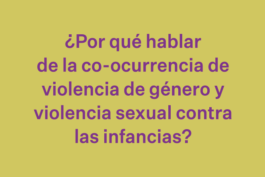



Historically, there have been two different fields of research and approach, which have followed parallel paths, without meeting points. However, gender violence and violence against children, in all its forms, go hand in hand. There are women who have been, or are, in a situation of violence with their partners or the parents of their children and, in this context, these children have been victims of sexual violence by that father.
When these mothers detect the violence suffered by their children and place themselves in a position of protection, complying with the steps that the same system establishes for these situations, they are called Protective Mothers.
Detection usually occurs after separation, and this is so for multiple reasons. Changes occur in daily life that foster a possible environment for disclosure: without violence in the home, the conditions for these children to speak or express themselves in some way improve (with their mother, in therapy, at school...), improvement the quality of the bond, the feeling of security increases, fear decreases, reliable spaces for exchange are generated, one learns -from one's own experience- about alternatives to set limits to violence, etc.
It is necessary and essential to keep in mind that while this happened and is happening, mothers have also been and are being victims of violence from the same person who sexually violates their children. This scenario does not place these women -or anyone else- in the best position to detect and intervene in the face of such an atrocity. However, protective mothers, overcoming this -the worst- context, do so.
In Shalom Bayt there are groups of Protective Mothers. These spaces are the support framework necessary to understand themselves, to break the isolation and form that essential and fundamental support network, which serves as containment to go through the complex moments on this path that they have begun.
They are NOT responsible for the occurrence of sexual violence against their children, but whoever commits it. Focusing on their “failure as detectors” implies leaving the person who exercises this form of violence out of sight and diluting their responsibility.

Historically, there have been two different fields of research and approach, which have followed parallel paths, without meeting points. However, gender violence and violence against children, in all its forms, go hand in hand. There are women who have been, or are, in a situation of violence with their partners or the parents of their children and, in this context, these children have been victims of sexual violence by that father.
When these mothers detect the violence suffered by their children and place themselves in a position of protection, complying with the steps that the same system establishes for these situations, they are called Protective Mothers.
Detection usually occurs after separation, and this is so for multiple reasons. Changes occur in daily life that foster a possible environment for disclosure: without violence in the home, the conditions for these children to speak or express themselves in some way improve (with their mother, in therapy, at school...), improvement the quality of the bond, the feeling of security increases, fear decreases, reliable spaces for exchange are generated, one learns -from one's own experience- about alternatives to set limits to violence, etc.
It is necessary and essential to keep in mind that while this happened and is happening, mothers have also been and are being victims of violence from the same person who sexually violates their children. This scenario does not place these women -or anyone else- in the best position to detect and intervene in the face of such an atrocity. However, protective mothers, overcoming this -the worst- context, do so.
In Shalom Bayt there are groups of Protective Mothers. These spaces are the support framework necessary to understand themselves, to break the isolation and form that essential and fundamental support network, which serves as containment to go through the complex moments on this path that they have begun.
They are NOT responsible for the occurrence of sexual violence against their children, but whoever commits it. Focusing on their “failure as detectors” implies leaving the person who exercises this form of violence out of sight and diluting their responsibility.